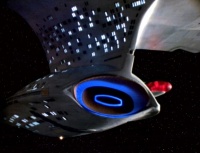Deflector Dish
The deflector dish (also called a navigational deflector, deflector array, or nav deflector) is a powerful forward-looking directional force-beam generator used to push aside debris, meteoroids, microscopic particulates, and other objects that might collide with the starship. It is indispensable during warp, because even the smallest space particle could cause severe damage to the ship during faster than light speeds. A deflector can also be extended around other vessels. The deflector acts as a form of defense for the vessel, as it can deflect to a certain degree laser fire and simple projectile weapons. The deflector cannot deflect more complex weaponry such as directed energy weapons or sophisticated projectile weapons.
The deflector dish is usually in the form of a dish-shaped force beam generator that contains heavy-duty subspace accelerators at the front end of a vessel’s secondary hull. A typical starship has one deflector, though it is becoming increasingly common for them to have more than one. Components of the deflector include a booster modulator, collimator, deflector field, emitter array, force beam generator, induction stabilizer, and maglock.
One detriment of using the deflector is that deflector beams can cause a great deal of subspace distortions, which can hinder the effect of the ship’s sensors. To overcome this, long-range sensor arrays are placed in a circular fashion around the deflector. By mounting them this way, it eliminates the interferences and actually increases the reception of data by the sensors.
The dish can be modified to channel a large quantity of energy as a weapon, but only in extreme circumstances as the energy requirements drain significant power reserves from other ship systems, notably the warp engines, and usually results in damage to the deflector dish. It can only be used this way at subwarp speeds. Due to the high levels of radiation produced by the energy beam, the decks near the deflector and any decks in front of the deflector would need to be evacuated.
